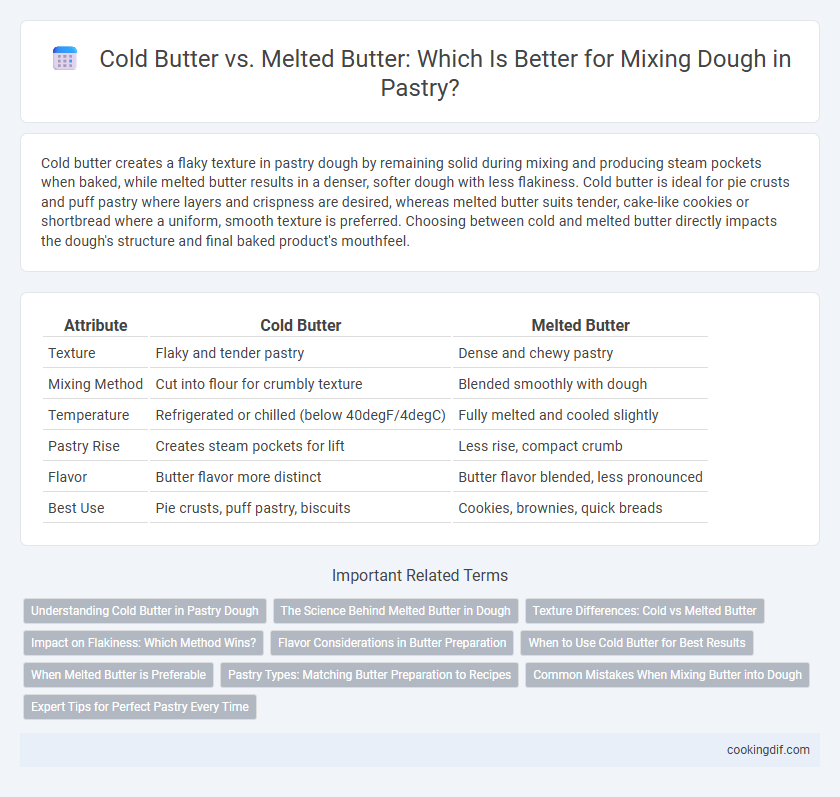Cold butter creates a flaky texture in pastry dough by remaining solid during mixing and producing steam pockets when baked, while melted butter results in a denser, softer dough with less flakiness. Cold butter is ideal for pie crusts and puff pastry where layers and crispness are desired, whereas melted butter suits tender, cake-like cookies or shortbread where a uniform, smooth texture is preferred. Choosing between cold and melted butter directly impacts the dough's structure and final baked product's mouthfeel.
Table of Comparison
| Attribute | Cold Butter | Melted Butter |
|---|---|---|
| Texture | Flaky and tender pastry | Dense and chewy pastry |
| Mixing Method | Cut into flour for crumbly texture | Blended smoothly with dough |
| Temperature | Refrigerated or chilled (below 40degF/4degC) | Fully melted and cooled slightly |
| Pastry Rise | Creates steam pockets for lift | Less rise, compact crumb |
| Flavor | Butter flavor more distinct | Butter flavor blended, less pronounced |
| Best Use | Pie crusts, puff pastry, biscuits | Cookies, brownies, quick breads |
Understanding Cold Butter in Pastry Dough
Cold butter in pastry dough creates a flaky texture by preventing the fat from fully blending with the flour, resulting in distinct layers as it melts during baking. Using chilled butter ensures minimal gluten development, maintaining tenderness while producing a light, airy crumb. This technique is essential for pastries like pie crusts, croissants, and puff pastry to achieve the desired crispness and flakiness.
The Science Behind Melted Butter in Dough
Melted butter in dough mixing alters the texture by fully incorporating fat, resulting in a denser and chewier pastry due to the lack of solid fat layers that create flakiness. The science behind melted butter involves its liquid state allowing gluten strands to develop more freely, reducing tenderness compared to cold butter, which inhibits gluten formation by remaining solid. This molecular interaction affects the final crumb structure, making melted butter ideal for moist, rich baked goods rather than light, flaky pastries.
Texture Differences: Cold vs Melted Butter
Cold butter in dough mixing creates a flaky and tender texture by forming distinct layers as it melts during baking, while melted butter results in a denser, chewier crumb due to its fully incorporated fat content. Using cold butter encourages steam pockets that puff up the dough, enhancing lightness and lift. Melted butter blends smoothly, leading to less rise and a more uniform, compact texture.
Impact on Flakiness: Which Method Wins?
Cold butter creates distinct, solid pockets within dough, resulting in a flakier texture as it melts during baking and releases steam. Melted butter blends uniformly, producing a denser, less flaky pastry due to the absence of these steam pockets. For optimal flakiness, cold butter is the preferred choice in dough mixing.
Flavor Considerations in Butter Preparation
Cold butter in dough mixing helps create flaky layers by solidifying pockets of fat during baking, resulting in a richer, buttery flavor with a delicate texture. Melted butter, on the other hand, blends fully into the dough, producing a denser texture and a more uniform, mellow butter taste. The choice between cold and melted butter directly influences the final pastry's flavor intensity and mouthfeel.
When to Use Cold Butter for Best Results
Cold butter is essential for creating flaky, tender pastry dough by preventing too much gluten development and ensuring small, distinct layers during baking. It is best used in recipes like pie crusts, biscuits, and puff pastry where a light, crumbly texture is desired. Keeping butter chilled until just before mixing helps achieve optimal dough consistency and superior final structure.
When Melted Butter is Preferable
Melted butter is preferable in dough mixing when a tender and moist texture is desired, such as in cakes or muffins where the fat integrates thoroughly with sugar and liquids. It provides a denser crumb by coating flour proteins more evenly, reducing gluten formation compared to cold butter which creates flakiness through solid fat layers. Using melted butter is ideal for recipes requiring quick mixing and a uniform batter consistency.
Pastry Types: Matching Butter Preparation to Recipes
Cold butter is essential for flaky pastries like pie crusts and puff pastries, as it creates steam pockets that result in a tender, layered texture. Melted butter works best in recipes such as cookie dough and certain cakes, where a denser, more uniform crumb is desirable. Selecting butter temperature based on the specific pastry type ensures optimal dough consistency and enhances the final baked product's quality.
Common Mistakes When Mixing Butter into Dough
Cold butter in dough mixing maintains distinct layers that create a flaky texture, while melted butter tends to blend fully, resulting in a denser pastry. A common mistake is using melted butter when a recipe calls for cold, which causes the dough to lose its structure and rise poorly. Overworking dough with cold butter can also lead to tough pastries as it causes excessive gluten development.
Expert Tips for Perfect Pastry Every Time
Cold butter creates a flaky, tender pastry by producing steam during baking that separates dough layers, essential for puff pastry and pie crusts. Melted butter results in a denser, more uniform texture, ideal for cookies or shortbread where tenderness is preferred over flakiness. Experts recommend chilling dough after mixing with melted butter to maintain structure, while keeping butter cold and handling dough minimally ensures optimal flakiness.
Cold butter vs Melted butter for dough mixing Infographic

 cookingdif.com
cookingdif.com